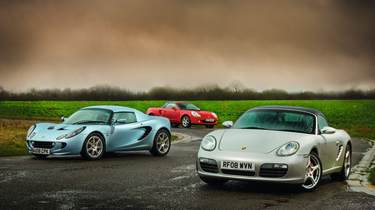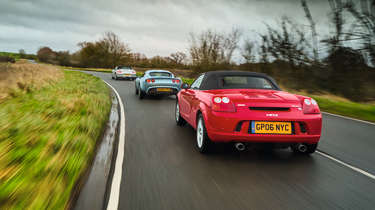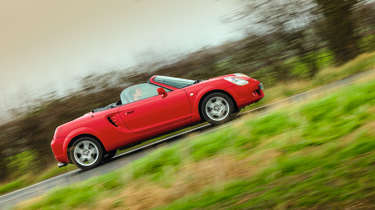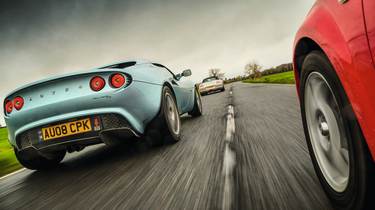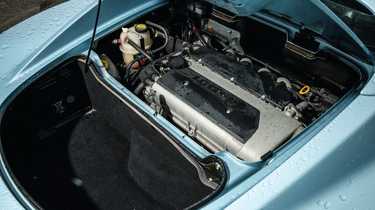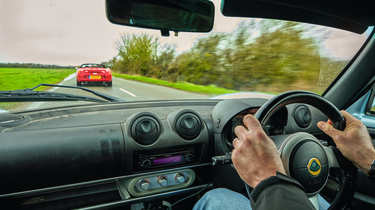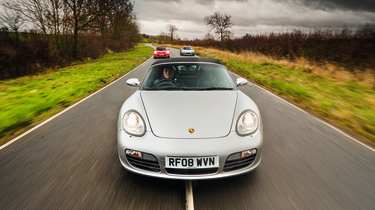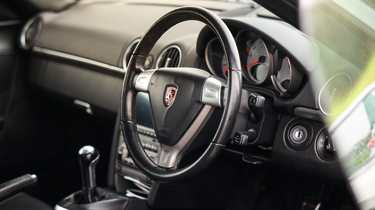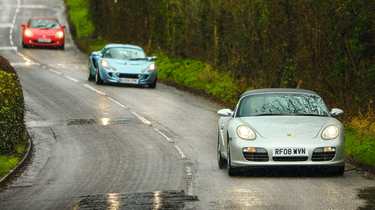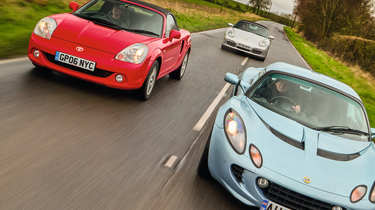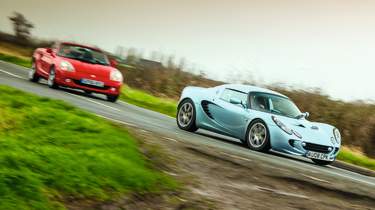Lotus Elise S2 v Toyota MR2 Mk3 v Porsche Boxster S 987: The best affordable mid-engined sports cars
Everyone should own a mid-engined car at least once in their life, and the S2 Elise, Mk3 MR2 and 987 Boxster S are brilliant places to start
A quick game of word association: think ‘mid-engined’. Does your mind run to supercars? GT40, F40, Gandini, Giugiaro…? The exotically cab-forward proportions the mid-engined layout lends itself to so well. Lots of cylinders, lots of horsepower, lots of drama.
Or does it flip to the other side of the coin: the small, nimble, neat sports car? Ever since little Coopers did battle with front-engined Ferraris on the Grand Prix circuit in the ’50s and ’60s, and Lotus took on the old-guard Offy-engined roadsters at Indy, light, compact cars that put the engine behind the driver’s shoulder blades and which can outpoint more powerful Goliaths have held a special kind of appeal.
> Cheap supercars: mid-engined exotics on a budget
Supercars are glorious, and so are front-engined sports cars. We’re assuredly not saying that mid-engined sports cars are ‘better’ (except, perhaps, from a purely scientific point of view in terms of on-paper weight distribution, moment of inertia and so on). But there’s something very special about starting one and hearing its heartbeat come to life behind you, rather than in front of you; the open, unencumbered view ahead; the inherent sense of agility the layout brings and the sense that you’re right in the centre of a snug vehicle created for driving – for fun – above all else.
It’s worth owning a mid-engined car at least once in your life. And it needn’t involve exchanging supercar-sized money. We’ve assembled three giant-killers in terms of affordability as well as ability. Each is a great used buy right now for different reasons: one has become a modern classic but remains under the radar in value; one is on the cusp of modern-classic status and can be had for tempting prices; and one is already an appreciating asset, but best enjoyed as a sports car to be driven, not closeted away as an investment.
I’m driving to meet contributing editor Adam Towler, together with an immaculate 987-gen Porsche Boxster S, a sweetly specced Lotus Elise S2 and their respective owners. And that mid-engined magic is there in truckloads in the car I’m travelling in, the far from truck-like, 3.9m-long Toyota MR2 Mk3.
Zipping along between the hedgerows, small wheels (15 inches at the front, 16 at the rear) and supple suspension soaking up the pock-marked, undulating B-road surface beneath, the Toyota is in its element: precise, nimble, poised. Handling balance is remarkably neutral – neither understeer nor oversteer – even in today’s sopping wet weather on trackday-spec Yokohama tyres. (Perfect conditions for testing three convertibles, naturally.)
The steering’s very light, but it’s not short on feedback. Dinky dimensions and narrow overall width help you flow down the road, choosing your own line. The dimensions are small enough that you can see the big, cartoonish headlights from the driver’s seat.
The MR2 is full of feel but the one thing it doesn’t feel is fast. Despite 138bhp and a sub-1000kg kerb weight, steep hills demand a downshift or two, and you need to work reasonably hard to keep pace with traffic. But that’s fine: this kind of car isn’t about acceleration, it’s about flow and momentum. And even if it’s not all that potent, the 1.8-litre, variable-timed 16-valve engine does have a likeable zingy crispness.
Power oversteer is not on the menu unless it’s snowing (a possibility today, given rain is occasionally morphing to sleet beneath the Toyota’s wipers) but it is possible to manipulate the car’s angle with momentum. Like many mid-engined cars, the MR2 gained a reputation for being occasionally tricky at the very limit and in 2003 underwent a light facelift, bringing a six-speed gearbox, staggered wheels, extra bracing for the suspension and altered spring/damper settings, making its handling less twitchy in extremis. Dickie Meaden’s evo test in period found the rear axle better controlled than the original car’s, less prone to roll-oversteer. This 2007 car feels neatly balanced.
The six-speed ’box is a delight: ultra-short in throw, and ultra-precise yet light and easy – just like all the other controls. The pedals are positioned just so and, oddly, despite there being so many years between them, there’s something about the MR2’s control weights that puts me in mind of the later GT86 and GR86 (though the roadster’s gearshift is light years better).
Just a shame the steering wheel is mounted so low. It has a small range of rake adjustment from too-low to far-too-low, and no telescopic reach adjustment. I’m just over average height and the bottom of the wheel fouls on the top of my thighs, even when I set the seat back further than normal. At least I’m wearing shiny waterproof trousers today in preparation for the weather, so there’s less resistance.
The interior is shiny-plasticky too, but neatly laid out with everything you need, and its tough construction means it’s remained in good nick. Particularly so in this car, an immaculate TF300 edition, one of the last 300 MR2s to be sold in the UK. On just 20,000 miles, its value is likely in the low teens. But this is an exception; more representative MR2 Mk3 values range from £7000 or so for a really excellent car to £3500 or thereabouts for a good one. An average one can still be had for £2000, or less for one that needs work.
When the MR2 was new I thought it a bit effete, a bit toy-like. Today it feels as pure a driving experience as they come.
Almost as driven-snow pure as the Lotus Elise, which carries some extra grit to match the additional budget required to buy one. If the MR2 has become a semi-forgotten, thoroughly affordable modern classic, the Elise is a much-celebrated, increasingly valuable car. Series 2 models were for some time more affordable than the more sought-after S1 original but they too have now risen in value.
As with all Elise generations, there’s a dizzying number of variants and special editions. Tested here is an Elise R, a core Elise model previously called the 111R until Lotus dropped the numbers from its name for 2007. The S2 Elise generation, introduced in 2001, was initially offered with both Rover K-series and Toyota engines, before the former model was discontinued in 2005 and replaced with the Elise S, using another, less powerful 1.8-litre Toyota engine. (Incidentally, from a similar family to the engine in the MR2, but not the same unit.) A further version later added a supercharger to the R’s engine to make it the Elise SC.
New, the original K-series S2 cost around £23k and the Elise R close to £30k (at first; the list price climbed further over the years). Ten years ago, you could snap up a K-series car for £11k. Sadly, and predictably, that’s no longer the case. Values start in the mid-teens, much like Elise S1s, with 111Rs and Rs in the low-to-high 20s depending on condition. On the flip side, look after the car and it’s unlikely to lose value.
The Lotus is a much more serious-feeling proposition than the Toyota. Just getting into this 2008 Polar Blue car is a challenge, particularly as it has the optional, smart-looking hardtop fitted, leaving a narrow gap through which to simultaneously limbo under the roof and vault over the high sill. Owner Charles White shows me around the car, which is close to standard spec barring a secondary aftermarket ECU, which slightly increases power and torque from the Toyota engine’s usual 189bhp and 131lb ft to a dyno-verified 200bhp and 138lb ft. More pertinently, it lowers the revs at which it hits its variable-valve-timing-assisted stride. It also has an upgraded clutch and an AiM data-logging system in place of the factory instruments, as Charles sprints and hill climbs the car, driving to and from every meeting. (He won his class last year, so it clearly runs well.)
Charles, who raced in the Manx motorcycle Grand Prix in the ’60s, is probably worth a story in his own right but the Elise, as ever, summons all of your attention. ‘I know we’ve said it so many times before, but it’s a “proper” sports car: an event… uncompromising… pure,’ Towler comments, having just driven the car himself.
It really is. Arms stretched out ahead to hold a tiny leather-bound steering wheel, settling into a lay-back driving position within the aluminium monocoque, it’s easy for your imagination to run away and make-believe you’re Jim Clark in a Lotus 25 at the old rain-lashed Spa circuit, rather than in a drizzly lay-by in Bedfordshire. As with the MR2, the steering wheel’s position is awkward: slightly too far away, slightly too low (particularly for Adam, who is taller than me). Charles mentions that the specialist that services his car offers spacers for the wheel, which could be a game-changer for tall drivers.
Underway, the view ahead over the front wings is fantastic, their curved, creased edges arcing directly over the front wheels. Infamously, the S2 was given narrower front tyres to make the handling less edgy at the limit than the S1, but Charles has fitted wider tyres to suit circuit demands (the exact same Yokohama tyres fitted to the MR2 here, coincidentally).
You get plenty of messages as to what the tyres are up to through the chassis you’re nestled within, and the unassisted steering. It’s remarkably light in weight, and calm either side of the straight-ahead. Later Elise S3s I’ve driven have chattier steering that sniffs and tugs at cambers but this car stays straight and true, then loads up sweetly through the various stages of a corner.
Biggest revelation is the ECU tweak. Ordinarily there’d be a step in power at around 6000rpm where the variable valve lift chimes in. In this car, it comes in at 5000rpm. ‘Lowering where the spicy valve lift comes into play really changes this car,’ Adam observes. ‘You used to have to hang on to every last rev to make progress in an R but that’s not the case with this wider torque band. The sense of progress is really enhanced.’
The gearshift demands concentration for a clean shift, more so than in the MR2. The Elise demands concentration in all aspects, in fact. It’s a totally absorbing experience.
Whereas the Porsche Boxster is a more refined, more grown-up experience – though still an enormously enjoyable and rewarding one. This pristine silver car is a 987-series Boxster, the second generation in the Boxster series (and the first to include the Cayman coupe sister car), sold from 2004 to 2012. Porsche claimed only around 20 per cent of components were carried over from the 986 Boxster, with the rest all-new.
Original 986 Boxsters have been temptingly cheap for some time now, available for MR2 money if you’re very brave, but the 987 too has now become a very affordable proposition. Bottom-dollar cars are available from £6000 or even less (though you could spend the same again or more putting a bad car right if you’re unlucky). Excellent condition, late-model cars can venture well into the £20k bracket, and special editions such as the rare RS60 are worth more, too. Reckon on prices in the low teens for a decent ‘Gen 1’ car – the pre-facelift 987 sold up to 2009.
This very tidy Gen 1 car is a Boxster S, which had the larger 276bhp (later upped to 291bhp) 3.4-litre engine rather than the entry-level 2.7. It’s also a manual, with a lovely, hefty but tactile six-speed shift (early 2.7 cars were five-speeds).
‘Unlike the other cars here it offers up a perfect driving position,’ Adam points out, ‘anchored low down in the car, and the wheel a perfect stretch away.’ Boxster interiors can suffer from tired trim if they’re not looked after, but that’s not the case in this car, which has aged gracefully. All the more since it’s retrofitted with Porsche’s PCCM touchscreen with Apple CarPlay and other up-to-date features.
I’m struck by how similar the interior feels to later 981-gen Boxsters: ergonomically, and also in terms of its control weights. The clutch pedal is heavy and needs a firm press, as does the brake. The steering is hefty too, the opposite of the fingertip-light Toyota. It lends the car a solid feel; not heavy or cumbersome, but more substantial than the other two cars.
Faster too, though since we’ve been spoiled by the interstellar performance of today’s cars, it doesn’t feel rapid by modern standards, even with 291bhp. But it’s more than quick enough. As Towler says, ‘The engine makes all the right noises after the other two. It’s so smooth, so turbine-like. For a road car, no more power than this is strictly necessary.’
There’s a little more subtle flex in the earlier generation car’s structure than the later 981-series Boxster (a similar sensation to the MR2, in fact), and the ride is tougher than normal on this car’s optional larger wheels (19 inches to the standard 18s) but still perfectly tolerable. If you were going to do a long journey in one of these cars, it’s the Porsche you’d grab the keys to. And even if it’s less immersive than the Elise and less effervescent than the MR2, it really does handle beautifully. ‘I love the way it changes direction,’ Adam says. ‘In the others, you’re aware the mass of the engine is fairly high and a long way back, but in the Boxster the fact the engine is on the floor nestled behind the seats really shows. You feel that in the way it tackles crests, too. There’s this poise and polish that defines the car.’
It’s also worth mentioning that it’s by far the most practical here. Open the rear bootlid and you can’t see the engine as you can in the other two cars, just an access panel for fluids. But there is a decent-sized boot, and a bigger-still luggage compartment in the nose. The Elise demands a bit of careful packing in its single narrow boot cavity behind the engine (put the biggest bag in first) and the Toyota… doesn’t have a boot. There’s a little room in the nose, next to the spare wheel, and lockable compartments behind the seats, but such is the car’s driver-focused nature that practicality isn’t really in its repertoire.
Adam sums up the Boxster by declaring ‘it seems such good value, no home should be without one’. Post-facelift ‘Gen 2’ 987s command much bigger money than Gen 1 cars, often above £20,000. ‘I looked at Gen 2 cars initially, because the Gen 1 car has a reputation for issues with the intermediate shaft (IMS) bearing and bore-scoring,’ explains this Boxster’s owner, Ben Cook. ‘But there’s a good chunk of money’s difference between a Gen 1 and Gen 2 car, so we decided a good Gen 1 would represent better value. With the dual boots, it’s probably more practical than a 911; you can get big suitcases in the front, and I transported a tree with the roof down at Christmas.
‘I love the view out over the front wings, the way it’s reminiscent of classic Porsche Speedsters. Yet it also doesn’t feel so small that you’re vulnerable around bigger cars. It’s been nothing but a pleasure to own,’ Ben concludes.
As always, you should look before you leap. Jason Shepherd at Porsche specialists Paragon cautions: ‘The first cars are now the thick end of 20 years old, so of course there are not-very-good ones out there. Some will have had accidents, large or small. Look under the front boot carpet: you want to see that it’s not finished to the same standard as the exterior; Porsche didn’t do that, so it could be a sign of repair. Interior buttons and sliders can lose their black finish; it’s an inexpensive fix, and a good sign a car’s been cherished if the interior still looks good.
‘The Gen 1 and Gen 2 engines are quite different,’ he adds. ‘Though there is a reputation for Gen 1 cars to suffer IMS bearing failures – and in the worst-case scenario it writes the engine off – we’ve only seen one in ten years. Bore-score is more likely on an S than a 2.7. Look for oily exhaust tips, get an inspection done and take somebody knowledgeable with you to hear the car running once it’s warmed up.’
Check the radiators and condensers at the front of the car, which can get blocked by leaves and rubbish. ‘If they’ve not been cleaned out, it’s a sign the car’s not been cared for,’ Shepherd says. ‘They need changing at some point, and you can spend the thick end of £3000, including the crossover pipes. Find out if they’ve been done already and if so, when.’
Above all, he concludes, it’s worth spending some time waiting for the right car to become available and paying what it’s worth.
The Mk3 MR2’s bête noire is the pre-cat disintegrating and bits getting into the engine with potentially terminal results. Early cars’ cylinders could become ovoid over time, allowing oil to run into the pre-cat. Modified oil rings helped avoid this on post-’03 cars, though many owners remove the pre-cats altogether.
Former MR2 owner Andrew Brady had one issue with his 2005 car: ‘An O2 sensor went at around 60,000 miles, a common thing. I changed it myself; the component was cheap to buy on eBay. I had it serviced once a year, and sold it for more than I paid for it, though that was in lockdown when values spiked slightly. If you buy a decent one it’s probably always going to be worth what you paid for it.
‘The only negative for me was the lack of luggage space; I’ve had an MX-5 and a Boxster since then, and both have been much more practical.’ A bigger negative for Towler is the driving position: ‘I think the MR2 is a brilliant size; I love the fact you’re almost brushing shoulders with your passenger, and can reach across and touch the passenger side door top. These are fundamental attributes of a sports car to me. The issue is that it doesn’t offer the adjustment necessary. The seat cushion is too high for me, and there isn’t the option to bring the wheel up and out. I feel like I’m driving a kid’s pedal car…’
Ben gets the Boxster a full service every two years at ‘around £250’ and changes its fluids once a year. Charles has the Lotus serviced annually and has put 35,000 miles on the car (more than a few of them on track) since he bought it in 2015 on 30,000 miles. Despite Lotus’s mixed reputation for reliability, he’s only ever experienced one failure, though a dramatic one, when ‘the clutch exploded at Snetterton’. He replaced it with an uprated item and hasn’t experienced any problems since.
This isn’t the sort of test where you pick a winner. Each of these cars is so different: the Elise is the most exhilarating, the most intensely rewarding experience; the Boxster by far the easiest to live with, the one you could drive every day; the MR2 the biggest bargain and a real revelation in its driving experience (though it could do with a steering wheel spacer). You could make a case for any of the three, and you’d be right, because it depends what you want from a sports car.
‘I went for a five-hour drive in the sunshine last summer,’ Boxster owner Ben says. ‘I didn’t realise I’d been gone that long.’ Which perhaps sums up these cars’ appeal better than any data – performance or market – ever could.
Specs
| Lotus Elise R (S2) | Toyota MR2 Roadster | Porsche Boxster S (987) | |
| Engine | In-line 4-cyl, 1796cc | In-line 4-cyl, 1794cc | Flat-six, 3387cc |
| Power | 189bhp @ 7800rpm | 138bhp @ 6400rpm | 291bhp @ 6250rpm |
| Torque | 133lb ft @ 6800rpm | 125lb ft @ 4400rpm | 251lb ft @ 4400-6000rpm |
| Weight | 860kg | 960kg | 1355kg |
| Power-to-weight | 223bhp/ton | 146bhp/ton | 218bhp/ton |
| Tyres as tested | Yokohama A08RS | Yokohama A08RS | Bridgestone Potenza |
| 0-62mph | 5.1sec | 7.9sec | 5.4sec |
| Top speed | 147mph | 131mph | 169mph |
| On sale | 2001-2011 | 2000-2007 | 2004-2012 |
| Price new | £35,416 (R, 2008) | £18,015 (TF300, 2007) | £40,050 (S, 2008) |
| Value today | £15,000-£30,000 | £2000-£13,000 | £6000-£29,000 |
With many thanks to Charles White, and Phil and Ben Cook.
This story first featured in evo issue 320.
